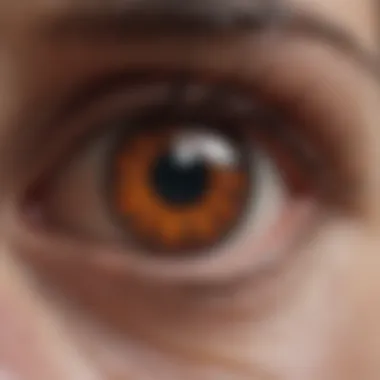Understanding HIV Transmission through Ocular Pathways


Intro
HIV transmission through ocular pathways presents a complex and often overlooked aspect of the virus's epidemiology. While the primary modes of transmission are well-researched and documented, understanding how HIV can spread through the eyes is crucial for developing comprehensive public health strategies. This article aims to explore these dynamics in depth, highlighting the biological mechanisms, risk factors, and the wider implications for health policy and individual behaviors.
The significance of investigating ocular transmission lies not only in enhancing clinical understanding but also in informing preventative measures and educational initiatives aimed at at-risk populations. Uncovering these pathways provides insights that might alter conventional perceptions of HIV transmission and encourage more nuanced approaches in dealing with the disease.
Research Context
Background and Rationale
HIV primarily spreads through sexual contact, sharing needles, and from mother to child during childbirth or breastfeeding. However, recent studies suggest that the ocular route may also pose a risk, albeit less understood. The rationale for exploring this route stemmed from cases where ocular exposure has been documented, prompting researchers to ask how biological mechanisms facilitate this potential pathway.
The human eye is an integral part of the immune system, and factors such as tear film chemistry, the presence of specific receptors, and the anatomical structure of the eye can influence the likelihood of HIV transmission. Furthermore, understanding this mode can aid in implementing protective measures.
Literature Review
In conducting this investigation, it is vital to assess the existing body of literature. Early studies primarily focused on ocular lesions in individuals with HIV, noting that systemic infections might also lead to ocular complications. More recent research has examined direct ocular exposure, particularly in healthcare settings where exposure to blood or bodily fluids is relevant. These studies highlight:
- The presence of CD4 receptors in ocular tissues and their potential role in viral entry.
- Risk factors such as occupational exposure for healthcare workers.
- The implications for vertical transmission during childbirth, where sufficient viral load may lead to exposure through tears or other ocular fluids.
The review indicates a pivotal need for further empirical evidence, particularly concerning the prevalence of this transmission route in specific demographics.
Methodology
Research Design
A mixed-methods approach will be employed for this investigation, incorporating both quantitative and qualitative research designs. This method allows for a comprehensive examination of the ocular pathways by quantifying existing data while also gaining insights from experiences and observations within the healthcare community.
Data Collection Methods
Data will be collected through a combination of systematic reviews of peer-reviewed journals and surveys targeting healthcare professionals involved in HIV care. Potential sources include:
- Scholarly articles from databases like PubMed and clinical trials discussing ocular transmission.
- Interviews and surveys with practitioners to gather anecdotal evidence regarding ocular exposure in clinical settings.
- Analysis of case studies where ocular transmission has been suggested or confirmed.
This approach aims to synthesize findings from multiple angles, ensuring a holistic understanding of the topic and informing future research directions and health policies.
Preface to HIV Transmission
Understanding HIV transmission is crucial to addressing the ongoing challenges posed by the virus. It not only informs public health initiatives but also shapes educational strategies that target at-risk populations. As health professionals and researchers delve into various transmission pathways, the ocular route represents a lesser-explored yet significant aspect of HIV transmission dynamics. This article aims to elucidate the mechanisms by which HIV may potentially enter the body through the eyes, alongside the implications for ocular health and overall well-being.
The significance of examining HIV transmission through ocular pathways lies in several key elements. First, the eyes are often overlooked in traditional discussions about HIV risks. The focus typically remains on more commonly acknowledged routes, such as sexual contact and blood exposure. However, the ocular surface is vulnerable and may act as a route for viral entry, particularly in individuals with pre-existing eye infections or conditions that compromise the ocular barrier. By expanding the understanding of how HIV can be transmitted through the eyes, public health strategies can be refined to reduce associated risks.
Moreover, this exploration aids in comprehending the broader epidemiological landscape of HIV. As populations become increasingly mobile and interconnected, knowledge of all possible transmission routes becomes necessary.
Public awareness is another vital consideration. Ensuring that communities are informed about the possibility of ocular HIV transmission can empower individuals to take preventive measures and seek timely medical advice when needed.
In summary, the introduction of this exploration into HIV transmission through ocular pathways is not merely an academic pursuit. It has real-world implications for health policy, patient care, and individual behavior. Understanding these dynamics enhances collective efforts to mitigate the transmission of HIV and improve health outcomes for diverse populations.
Overview of HIV


HIV, or Human Immunodeficiency Virus, is a retrovirus that attacks the immune system, specifically targeting CD4 cells. Without treatment, HIV can lead to Acquired Immunodeficiency Syndrome (AIDS), a condition where the immune system becomes severely compromised. This shift leads to increased susceptibility to opportunistic infections and certain cancers.
Globally, HIV remains a significant public health concern, affecting millions. Although treatment options exist, such as antiretroviral therapy, which help manage the virus and improve quality of life, the stigma associated with HIV continues to hinder effective prevention strategies.
Mechanisms of Viral Transmission
The mechanisms of HIV transmission are well-documented, primarily focusing on blood, sexual fluids, and mother-to-child transmission. However, emerging research suggests that the eye could serve as a potential pathway. This possibility hinges on the anatomy of the eye and its biochemical environment, which may allow viral entry under specific conditions.
The conjunctiva, a thin membrane covering the whites of the eyes and inner eyelids, is particularly relevant. It is rich in mucosal surfaces and immune cells but can also be a route for pathogens. In scenarios of trauma, such as penetration injuries or insertion of foreign bodies, the risk of HIV becoming introduced to the bloodstream through the ocular tissues increases. Further studies emphasize the need to investigate the specific conditions under which transmission is plausible.
The Eye as a Potential Entry Point
The discussion surrounding HIV transmission often focuses on well-known routes, such as sexual contact and sharing of needles. However, the eye represents a unique and underappreciated entry point for the virus. Understanding the eye's role in HIV transmission is critical for both clinical practice and public health initiatives. The ocular surface could facilitate the entry of pathogens, including HIV, which may alter risk profiles in specific populations.
Recognizing the eye's potential vulnerability urges a thorough examination of ocular anatomy and surface characteristics. Factors such as pre-existing ocular conditions and general health status can also enhance or mitigate this risk. This section provides a framework for comprehending how the eye might serve as an entry point for HIV transmission.
Anatomy of the Eye
The eye comprises several anatomical structures that play key roles in vision and overall eye health. Key components include:
- Cornea: The clear front layer of the eye, responsible for focusing light.
- Conjunctiva: A thin membrane covering the eye's surface and the inner eyelids.
- Sclera: The white outer coating that provides structural support.
- Lens: A transparent structure that further focuses light onto the retina.
These components together form a delicate barrier against external aggressors, but they are not impermeable. The cornea and conjunctiva can be exposed to various pathogenic microorganisms. As lymphatic and vascular connections exist in these areas, they can facilitate the transport of infectious agents, including HIV, into the systemic circulation.
Additionally, understanding the metabolic and immunological functionality inherent within the eye can aid in exploring the mechanisms by which HIV might exploit these channels for transmission.
Ocular Surface and Vulnerability
The ocular surface remains a primary contact point for environmental pathogens. Factors such as:
- Tears: Their role in flushing away contaminants can be overwhelmed under certain conditions.
- Damage or abrasions: Injuries due to trauma or foreign bodies can create pathways for viral entry.
- Co-existing infections: The presence of other ocular infections may compromise the integrity of the ocular surface.
The eye's adsorption capabilities further complicate the picture. Studies have shown that HIV's proteins can interact with eye tissues. This interaction may increase susceptibility to the virus under certain circumstances. Conditions like conjunctivitis, which cause inflammation, may present additional risks as they alter the barrier function of the ocular surface.
Empirical Evidence of Ocular HIV Transmission
Understanding the empirical evidence of ocular HIV transmission is crucial for multiple reasons. First, it helps to identify how HIV can enter the body through the eyes, which is often overlooked in transmission studies. This section focuses on various case studies and laboratory findings, underscoring the importance of comprehensive research in understanding this potential route of infection. It informs clinical practices and public health strategies, making it a vital topic for students, researchers, and healthcare professionals.
Case Studies and Reports
Several case studies have reported ocular exposure to HIV, providing valuable insights into the dynamics of transmission through the eyes. One noteworthy study documented a healthcare worker who contracted HIV after an accidental splash of HIV-infected blood into their eye. The rapidity of viral replication and the health of the ocular surface can influence infection likelihood.
Other case reports involve patients with conjunctivitis or other eye diseases who were found to have HIV present in their ocular secretions. These reports highlight the significant role that compromised ocular health can play in increasing vulnerability to HIV infection. Such incidents emphasize the necessity for protocols that protect health workers and patients alike from ocular exposure in healthcare settings.
Additionally, literature has examined the cases of infants born to HIV-positive mothers. Some studies found the virus in nasolacrimal secretions, indicating potential transmission through tears. These findings call for more extensive studies to assess risks and develop effective prevention strategies, particularly in maternal and neonatal health.
Laboratory Findings
Laboratory studies complement case reports by offering controlled environments to explore HIV’s ocular transmission mechanisms. Research has shown that HIV can infect ocular tissues. Experiments carried out using tissue culture systems revealed that HIV could indeed infect corneal cells, signaling that the eye can serve as a potential entry point for the virus.
Further investigation into the mechanisms has uncovered that certain receptors, like CD4 and co-receptors CCR5 and CXCR4 present on ocular cells, may allow for HIV binding and entry. These findings underline the need to conduct further research into the anatomical and clinical implications of ocular HIV infection.


Moreover, studies involving tear fluid have shown that the presence of HIV RNA can be detected in some individuals, suggesting that infectious virus can exist in the ocular secretions. This poses important questions about the conditions under which HIV is transmitted through ocular pathways and calls for further inquiry into the persistence of the virus in such environments.
Factors Influencing Risk of Eye Transmission
Understanding factors influencing risk of eye transmission is crucial in the context of HIV transmission through ocular pathways. This examination not only identifies the pathways through which the virus may enter but also evaluates the biological and environmental factors that can elevate these risks. These factors accumulate in importance as they offer an insight into how health professionals can tailor interventions, engage affected populations, and address concerns.
Ocular Health Status
Ocular health status plays a significant role in the susceptibility of the eye to HIV transmission. Individuals with pre-existing ocular conditions are often at a higher risk. Conditions such as conjunctivitis or keratitis diminish the eye's protective barriers, making it easier for viruses to penetrate. Additionally, conditions like dry eye syndrome can lead to increased vulnerability due to reduced tear film that normally protects the ocular surface.
Research indicates that compromised ocular health can facilitate the entry of not just HIV but also other pathogens. The consideration here extends beyond just the surface health. Systemic health conditions affecting the immune system or leading to ocular issues must also be acknowledged. For instance, immunocompromised individuals may find their eyes more susceptible to infections and, consequently, to HIV.
- Key considerations on ocular health status include:
- The presence of chronic diseases (e.g., diabetes) affecting eyes.
- The impact of medications that may either impair ocular function or enhance the risk of infections.
- The role of environmental factors like UV exposure that might alter the eye’s integrity.
Presence of Co-infections
Presence of co-infections significantly affects the risk of HIV transmission via ocular routes. Many individuals living with HIV also deal with other infections, which can compound the risks associated with ocular health. For example, co-infections such as viral hepatitis or herpes simplex virus can compromise the immune function, making the eyes more vulnerable. These co-infections can alter the inflammatory response in ocular tissues, potentially serving as a conduit for HIV entry.
Moreover, certain sexually transmitted infections can increase the shedding of the HIV virus in bodily fluids. This presents an increased likelihood of exposure through ocular contact. It is essential to consider that even minor ocular injuries or irritations can provide a portal for HIV to enter the bloodstream, especially in individuals with co-infections.
- Factors related to co-infections include:
- The potential for ocular manifestations of co-infections, such as in cases of herpes keratitis.
- The need for integrated healthcare approaches that account for multiple co-morbidities.
- The significance of education in prevention methods, particularly for high-risk populations.
Understanding these factors is vital for shaping effective intervention strategies. Addressing ocular health and the presence of co-infections can lead to more comprehensive care models that protect vulnerable populations.
Preventative Strategies
Preventative strategies are crucial in mitigating the risk of HIV transmission through ocular pathways. Understanding how to protect the eyes from potential infection is an integral part of comprehensive healthcare, especially for those at risk. Various approaches can enhance eye safety and serve as a buffer against potential contamination. These strategies not only aim to safeguard individual health but also contribute to public health efforts.
Safe Practices for Eye Care
Practicing safe eye care is fundamental in preventing HIV transmission. Adopting specific behaviors can assist in minimizing potential risks. Consider the following practices:
- Hand Hygiene: Regularly wash hands with soap and water, particularly before touching the eyes. This simple act can significantly reduce the chance of introducing pathogens.
- Avoid Rubbing Eyes: Rubbing the eyes, especially with unwashed hands, can increase vulnerability. The act can inadvertently create micro-abrasions on the ocular surface.
- Use Protective Wear: In environments where exposure to bodily fluids is possible, such as healthcare settings, using goggles or face shields can protect the eyes from splashes or contact with contaminated materials.
- Regular Eye Exams: Visiting an eye care professional for regular check-ups helps in maintaining ocular health and allows for early detection of any possible infections or anomalies.
- Personal Use Items: Avoid sharing personal eye care items, such as makeup, contact lenses, and solutions. Each individual should use their own products to prevent the transmission of harmful pathogens.
Implementing these safe practices can create a more resilient ocular environment, significantly reducing the risk of HIV exposure through the eyes.
Public Health Recommendations
Public health recommendations play a vital role in addressing the issue of HIV transmission via ocular pathways. Health authorities worldwide emphasize the importance of awareness and education. The following points highlight essential aspects of public health strategies:
- Awareness Campaigns: Initiating campaigns that highlight the risks and mechanisms of ocular HIV transmission can enhance understanding among the general population.
- Healthcare Training: Training programs for healthcare workers on the importance of ocular health in the context of HIV can improve clinical practices and patient education.
- Integration into HIV Testing: Encouraging eye examinations as part of comprehensive HIV testing protocols ensures that ocular health is not overlooked in at-risk populations.
- Collaboration with Eye Health Organizations: Partnerships with eye health institutions can help in addressing concerns specific to ocular transmission of HIV. Combining resources can strengthen the overall approach.
- Policy Implementation: Governments and health organizations should implement policies that promote ocular health and preventive measures. Regulatory frameworks can guide proper practices in both clinical and non-clinical settings.
By incorporating these public health recommendations, communities can work together to create an environment where the ocular transmission risk is significantly reduced. Improving knowledge, practice, and policy contributes to the broader goal of combating HIV effectively.
Global Perspectives on HIV and Eye Health
Understanding the global perspectives on HIV and eye health is crucial, mainly due to the potential for ocular transmission, which remains under-discussed yet significant. This section highlights the varying dynamics of HIV as it intersects with eye health across different populations.


"A comprehensive understanding of the patterns of HIV transmission through ocular pathways can inform better prevention strategies and health policies."
Epidemiological Trends
Epidemiological trends provide a vital landscape of the ongoing HIV epidemic and its connection with eye health. Various studies note an increase in HIV infections in regions with high rates of ocular diseases. Data suggests that populations suffering from conjunctivitis or keratitis may experience a heightened risk for HIV transmission through ocular routes due to compromised ocular surfaces.
In addition, it is essential to consider socio-economic factors contributing to HIV transmission rates. Access to healthcare varies widely, depending on different regions and economic statuses. For example, lower-income countries often face higher rates of HIV, correlating with limited access to eye health services. Understanding these trends helps to identify priority areas for interventions.
Key Points on Epidemiological Trends:
- Rising Infection Rates: Countries with high ocular disease prevalence report increased HIV cases, warranting further investigation.
- Healthcare Accessibility: Limited access to healthcare can exacerbate ocular health issues, resulting in higher transmission risk.
- Socio-economic Influence: Economic conditions play an influential role in both HIV spread and eye health services availability.
Regional Variations in Transmission Risks
Transmission risks for HIV via ocular pathways can differ significantly by region. Variations stem from cultural practices, healthcare systems, and levels of awareness about HIV and eye health. In some areas, traditional beliefs may influence how eye ailments are treated or perceived, potentially impacting the risk of transmitting HIV.
For instance, in regions where sexual health education is lacking, individuals may not realize the risks associated with ocular transmission. Moreover, regions facing higher rates of co-infection with other diseases, such as syphilis or viral hepatitis, may find that these conditions can exacerbate the risk of HIV transmission.
Notable Regional Considerations:
- Awareness Levels: Higher awareness of HIV and its transmission methods leads to more cautious behaviors.
- Cultural Practices: Traditional health beliefs can hinder or assist in effective eye care, impacting risk levels.
- Co-infection Risks: Areas with a high prevalence of other STIs can see increased risks of HIV ocular transmission.
In summary, recognizing global perspectives on HIV and eye health is imperative for shaping effective public health initiatives and optimizing prevention strategies. Addressing both epidemiological trends and regional variations can ultimately contribute to better outcomes in managing HIV transmission through ocular pathways.
Clinical Implications and Future Directions
The topic of HIV transmission through ocular pathways warrants significant attention in clinical practice and public health initiatives. Understanding how HIV may be transmitted through the eyes can help inform protocols in both eye care settings and broader healthcare services. This knowledge also raises important considerations about integration of eye health and HIV services, ensuring that practitioners are equipped to manage potential risks associated with ocular exposure to HIV.
Integration of Eye Care in HIV Services
Combining eye care with HIV services can enhance patient outcomes. Many individuals living with HIV may suffer from ocular health issues, either directly due to the virus or as a result of opportunistic infections. Proper screening for ocular conditions should be incorporated into regular HIV consultations.
- Referral Systems: Establishing strong referral pathways between HIV specialists and ophthalmologists can lead to timely interventions.
- Training for Healthcare Providers: Education on the link between ocular health and HIV transmission is essential for clinicians. This ensures they're aware of signs and symptoms that could indicate both HIV and eye health disorders.
- Holistic Patient Management: Addressing the patient as a whole, rather than segregating treatment, promotes better adherence to both HIV medication and eye treatments. This integrated approach fosters a more comprehensive understanding of a patient’s overall health.
Future Research Priorities
Further research is essential to fully comprehend the implications of ocular HIV transmission. Future studies should focus on several key areas:
- Transmission Mechanisms: Investigating the precise biological processes involved in ocular transmission can clarify risks and inform prevention strategies.
- Epidemiological Studies: Large-scale studies are needed to assess the prevalence of ocular HIV transmission across different populations and settings.
- Prevention Strategies: Developing and testing specific guidelines to minimize the risk of ocular transmission is crucial. These could include education for at-risk populations about eye protection during medical procedures.
- Longitudinal Studies: Research should track the health outcomes of individuals with HIV concerning ocular health over time to gather more conclusive data on this transmission pathway.
"Understanding and addressing the potential for HIV transmission through ocular pathways is not just an academic pursuit. It has real implications for public health and individual care."
By delving deeper into these areas, we can ensure that healthcare systems are prepared for potential risks associated with HIV and ocular health, ultimately leading to more informed and effective public health responses.
Ending
The exploration of HIV transmission through ocular pathways is crucial for several reasons. First, it sheds light on a potential, yet often overlooked, route of HIV infection that could have implications for public health strategies. Understanding these pathways enhances our knowledge of how the virus can interact with various biological systems. This understanding is especially pertinent in contexts where traditional transmission routes are well-known, yet new directions may emerge.
Summary of Findings
In summary, this article has highlighted the characteristics of the eye that may facilitate the entry of HIV, including the delicate anatomical features and the vulnerability of the ocular surface. Studies and case reports provide empirical evidence supporting the notion that transmission through the eyes is possible, albeit rare. Furthermore, we reviewed the risk factors associated with ocular health that could influence the likelihood of transmission. Key factors include the presence of co-infections, the overall immune status of the individual, and pre-existing eye conditions.
Call to Action for Research and Policy
It is essential for researchers and policymakers to prioritize further investigation into ocular HIV transmission. Funding and resources should be allocated to study its implications more thoroughly. As public health recommendations evolve, integrating eye care into comprehensive HIV services can improve outcomes. We need a multipronged approach, combining education and updated medical practices, to inform both healthcare professionals and the broader public about risks associated with ocular transmission.
Addressing this gap in understanding can lead to refined health policies and enhanced patient care strategies.



